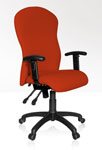When your back can be such a pain...

Here are a few easy tips from physiotherapist and ergonomics specialist Gary Arenson that will help you to adjust your work space to avoid lower back pain, headaches and other common work-related injuries.
1. Take adequate work breaks: Our bodies are not designed to sit for long periods of time and therefore our muscles get tired when we do. Make sure you stand up from your desk and walk around at least every half an hour.
2. Make sure that your feet are flat on the floor: If your feet don't reach the floor, invest in a footrest.
3. Clear all obstacles underneath your desk: Any objects left at your feet result in you sitting in an awkward position. Nothing should be obstructing your feet.
4. Position your computer monitor correctly: The top most line of your monitor display should be approximately at eye level to avoid straining your neck.
5. Have your monitor and keyboard directly in front of you: Your monitor and keyboard should not be to the side of you, but directly in front. Keep the keyboard in close proximity with your shoulders relaxed and your wrists in line with your forearms.
6. Adjust you viewing distance: Your monitor should be as far as possible from you while you can still see the screen clearly (generally 45 - 65cm)
7. Get a headset: If you spend more than 50% of your day on the phone or need to type while on the phone, acquiring a headset would be wise.
8. Relook the way you use your laptop: The low position of laptop screens and positive angle of the keyboard make for very poor postures. Use a separate keyboard, mouse and monitor or get a laptop stand or docking station. If you're desperate, try raising the back of the laptop by placing a book/ream of paper underneath, effectively raising the screen and putting the keyboard at a slight upward angle.
9. Don't put your documents between you and your keyboard: You will be reaching forward for your keyboard - bringing your shoulders forward causes a rounded shoulder posture as well as muscle fatigue. Try using a document holder and have the documents at the same height as your monitor.
10. Change your office chair: Buy a chair that will offer you better lumbar and thoracic support, which will assist in correcting body posture. The GET ONE chair offered by Ergotherapy Solutions is locally designed and produced and is designed to be a fully adjustable ergonomic choice (www.ergotherapy.co.za).








